
Not for
Reproduction
6
Engine Control Symbols and Meanings
Engine speed - FAST
Engine speed - SLOW
Engine speed - STOP
ON - OFF
Engine start - Choke
CLOSED
Engine start - Choke OPEN
Fuel Cap
Fuel Shut-off - OPEN
Fuel Shut-off - CLOSED
Fuel level - Maximum
Do not overfill
Operation
Oil Recommendations
Oil Capacity:
See the
Specifications
section.
NOTICE
This engine was shipped from Briggs & Stratton without oil. Equipment manufacturers
or dealers may have added oil to the engine. Before you start the engine for the first
time, make sure to check the oil level and add oil as specified by the instructions in
this manual. If you start the engine without oil, it will be damaged beyond repair and
will not be covered under warranty.
We recommend the use of Briggs & Stratton
®
Warranty Certified oils for best
performance. Other high-quality detergent oils are permitted if classified for service SF,
SG, SH, SJ or higher. Do not use special additives.
Outdoor temperatures determine the correct oil viscosity for the engine. Use the chart
to select the best viscosity for the outdoor temperature range expected. Engines on
most outdoor power equipment operate well with 5W-30 Synthetic oil. For equipment
operated in hot temperatures, Vanguard
®
15W-50 Synthetic oil gives the best
protection.
A
SAE 30 -
Below 40 °F (4 °C) the use of SAE 30 will result in hard starting.
B
10W-30 -
Above 80 °F (27 °C) the use of 10W-30 may cause increased oil
consumption. Check the oil level frequently.
C
5W-30
D
Synthetic 5W-30
E
Vanguard
®
Synthetic 15W-50
Check and Add Oil
See Figure: 6
Before checking or adding oil
• Make sure the engine is level.
• Clean the oil fill area of any debris.
• See the
Specifications
section for oil capacity.
NOTICE
This engine was shipped from Briggs & Stratton without oil. Equipment manufacturers
or dealers may have added oil to the engine. Before you start the engine for the first
time, make sure to check the oil level and add oil according to the instructions in this
manual. If you start the engine without oil, it will be damaged beyond repair and will
not be covered under warranty.
Check Oil Level
1.
Remove the dipstick (A, Figure 6) and wipe with a clean cloth.
2.
Install and tighten the dipstick (A, Figure 6).
3.
Remove the dipstick and check the oil level. Correct oil level is at the top of the full
indicator (B, Figure 6) on the dipstick.
Add Oil
1.
If the oil level is low, slowly add oil into the engine oil fill (C, Figure 6).
Do not
overfill.
After adding oil, wait one minute and then check the oil level.
2.
Reinstall and tighten the dipstick (A, Figure 6).
Fuel Recommendations
Fuel must meet these requirements:
• Clean, fresh, unleaded gasoline.
• A minimum of 87 octane/87 AKI (91 RON). High altitude use, see below.
• Gasoline with up to 10% ethanol (gasohol) is acceptable.
NOTICE
Do not use unapproved gasolines, such as E15 and E85. Do not mix oil in
gasoline or modify the engine to run on alternate fuels. Use of unapproved fuels will
damage the engine components, which will not be covered under warranty.
To protect the fuel system from gum formation, mix a fuel stabilizer into the fuel.
See
Storage.
All fuel is not the same. If start or performance problems occur, change
fuel providers or brands. This engine is certified to operate on gasoline. The emissions
control system for carbureted engines is EM (Engine Modifications). The emissions
control systems for engines with electronic fuel injection are ECM (Engine Control
Module), MPI (Multi Port Injection), and if equipped an O2S (Oxygen Sensor).
High Altitude
At altitudes over 5,000 feet (1524 meters), a minimum 85 octane/85 AKI (89 RON)
gasoline is acceptable.
For carbureted engines, high altitude adjustment is required to maintain performance.
Operation without this adjustment will cause decreased performance, increased fuel
consumption, and increased emissions. Contact a Briggs & Stratton Authorized Service
Dealer for high altitude adjustment information. Operation of the engine at altitudes
below 2,500 feet (762 meters) with the high altitude adjustment is not recommended.
For Electronic Fuel Injection (EFI) engines, no high altitude adjustment is necessary.
Add Fuel
See Figure: 7
WARNING
Fuel and its vapors are extremely flammable and explosive.
Fire or explosion can cause severe burns or death.
When adding fuel
• Turn engine off and let engine cool at least 2 minutes before removing the fuel
cap.
• Fill fuel tank outdoors or in well-ventilated area.
• Do not overfill fuel tank. To allow for expansion of the fuel, do not fill above the
bottom of the fuel tank neck.
• Keep fuel away from sparks, open flames, pilot lights, heat, and other ignition
sources.
• Check fuel lines, tank, cap, and fittings frequently for cracks or leaks. Replace if
necessary.
• If fuel spills, wait until it evaporates before starting engine.
1.
Clean the fuel cap area of dirt and debris. Remove the fuel cap.







































